The Results of Applying Different Methodologies to 10 Years of Quantitative Precipitation Estimation in Catalonia Using Weather Radar
Abstract
:1. Introduction
2. Operational Methods of QPE at the Meteorological Service of Catalonia (SMC)
2.1. The Conveniences of Using the GeoTIFF Format
2.2. XRAD and XEMA Networks
2.3. Simple Corrections
2.4. EHIMI (Hydrometeorological Integrated Forecasting Tool) Corrections
2.5. EHIMI Corrections Combined with Rain Gauge Data
2.6. Post-Processed EHIMI Corrections Combined with Rain Gauge Data
2.7. Bias Estimation
3. Results
3.1. Radar Bias Evolution for the Period 2011–2020
3.2. The Yearly Cycle of the Bias
3.3. The Episode of 22 October 2019
4. Discussion
5. Conclusions
Author Contributions
Funding
Institutional Review Board Statement
Informed Consent Statement
Acknowledgments
Conflicts of Interest
References
- Llasat, M.C.; Rigo, T.; Villegas, J.J. Techniques and instruments to aid in the monitoring of flood events. In Floods; Vinet, F., Ed.; Elsevier: Amsterdam, The Netherlands, 2017. [Google Scholar]
- Hally, A.; Caumont, O.; Garrote, L.; Richard, E.; Weerts, A.; Delogu, F.; Fiori, E.; Rebora, N.; Parodi, A.; Mihalović, A.; et al. Hydrometeorological multi-model ensemble simulations of the 4 November 2011 flash flood event in Genoa, Italy, in the framework of the DRIHM project. Nat. Hazards Earth Syst. Sci. 2015, 15, 537–555. [Google Scholar] [CrossRef] [Green Version]
- Álvarez-Rodríguez, J.; Llasat, M.C.; Estrela, T. Analysis of geographic and orographic influence in Spanish monthly precipitation. Int. J. Clim. 2017, 37, 350–362. [Google Scholar] [CrossRef]
- Diez-Sierra, J.; del Jesus, M. A rainfall analysis and forecasting tool. Environ. Model. Softw. 2017, 97, 243–258. [Google Scholar] [CrossRef]
- Germann, U.; Berenguer, M.; Sempere-Torres, D.; Zappa, M. Real—Ensemble radar precipitation estimation for hydrology in a mountainous region. Q. J. R. Meteorol. Soc. 2009, 135, 445–456. [Google Scholar] [CrossRef] [Green Version]
- Doviak, R.J.; Zrnić, D.S. Doppler Radar and Weather Observations, 2nd ed.; Academic Press: Cambridge, MA, USA, 1993. [Google Scholar]
- Bech, J.; Codina, B.; Lorente, J.; Bebbington, D. The sensitivity of single polarization weather radar beam blockage correction to variability in the vertical refractivity gradient. J. Atmos. Ocean. Technol. 2003, 20, 845–855. [Google Scholar] [CrossRef] [Green Version]
- Altube, P.; Bech, J.; Argemí, O.; Rigo, T. Quality control of antenna alignment and receiver calibration using the sun: Adaptation to midrange weather radar observations at low elevation angles. J. Atmos. Ocean. Technol. 2015, 32, 927–942. [Google Scholar] [CrossRef] [Green Version]
- Nilsson, C.; Dokter, A.M.; Verlinden, L.; Shamoun-Baranes, J.; Schmid, B.; Desmet, P.; Bauer, S.; Chapman, J.; Alves, J.A.; Stepanian, P.M.; et al. Revealing patterns of nocturnal migration using the European weather radar network. Ecography 2018, 42, 876–886. [Google Scholar] [CrossRef] [Green Version]
- Wagner, P.; Fiener, P.; Wilken, F.; Kumar, S.; Schneider, K. Comparison and evaluation of spatial interpolation schemes for daily rainfall in data scarce regions. J. Hydrol. 2012, 464–465, 388–400. [Google Scholar] [CrossRef]
- Dirks, K.; Hay, J.; Stow, C.; Harris, D. High-resolution studies of rainfall on Norfolk Island: Part II: Interpolation of rainfall data. J. Hydrol. 1998, 208, 187–193. [Google Scholar] [CrossRef]
- Velasco-Forero, C.A.; Sempere-Torres, D.; Cassiraga, E.; Gómez-Hernández, J.J. A non-parametric automatic blending methodology to estimate rainfall fields from rain gauge and radar data. Adv. Water Resour. 2009, 32, 986–1002. [Google Scholar] [CrossRef]
- Schiemann, R.; Erdin, R.; Willi, M.; Frei, C.; Berenguer, M.; Sempere-Torres, D. Geostatistical radar-raingauge combination with nonparametric correlograms: Methodological considerations and application in Switzerland. Hydrol. Earth Syst. Sci. 2011, 15, 1515–1536. [Google Scholar] [CrossRef] [Green Version]
- Trapero, L.; Bech, J.; Rigo, T.; Pineda, N.; Forcadell, D. Uncertainty of precipitation estimates in convective events by the Meteorological Service of Catalonia radar network. Atmos. Res. 2009, 93, 408–418. [Google Scholar] [CrossRef]
- Tabary, P.; Boumahmoud, A.-A.; Andrieu, H.; Thompson, R.J.; Illingworth, A.J.; Le Bouar, E.; Testud, J. Evaluation of two “integrated” polarimetric quantitative precipitation estimation (QPE) algorithms at C-band. J. Hydrol. 2011, 405, 248–260. [Google Scholar] [CrossRef]
- Marra, F.; Morin, E. Use of radar QPE for the derivation of intensity–duration–frequency curves in a range of climatic regimes. J. Hydrol. 2015, 531, 427–440. [Google Scholar] [CrossRef]
- Llasat, M.C.; Llasat-Botija, M.; Rodriguez, A.; Lindbergh, S.; Llasat, M.C.; Llasat-Botija, M.; Rodriguez, A.; Lindbergh, S. Flash floods in Catalonia: A recurrent situation. Adv. Geosci. 2010, 26, 105–111. [Google Scholar] [CrossRef] [Green Version]
- Moral, A.; del Carmen Llasat, M.; Rigo, T. Connecting flash flood events with radar-derived convective storm characteristics on the northwestern Mediterranean coast: Knowing the present for better future scenarios adaptation. Atmos. Res. 2020, 238, 104863. [Google Scholar] [CrossRef]
- Moral, A.; Weckwerth, T.M.; Rigo, T.; Bell, M.M.; Llasat, M.C. C-band dual-doppler retrievals in complex terrain: Improving the knowledge of severe storm dynamics in catalonia. Remote Sens. 2020, 12, 2930. [Google Scholar] [CrossRef]
- Amengual, A.; Romero, R.; Gomez, M.; Martin, A.; Alonso, S. A hydrometeorological modeling study of a flash-flood event over catalonia, Spain. J. Hydrometeorol. 2007, 8, 282–303. [Google Scholar] [CrossRef] [Green Version]
- Pascual, D.; Pla, E.; Lopez-Bustins, J.A.; Retana, J.; Terradas, J.; Sanchez, D.P. Impacts of climate change on water resources in the Mediterranean Basin: A case study in Catalonia, Spain. Hydrol. Sci. J. 2015, 60, 2132–2147. [Google Scholar] [CrossRef] [Green Version]
- Skripniková, K.; Řezáčová, D. Comparison of radar-based hail detection using single- and dual-polarization. Remote Sens. 2019, 11, 1436. [Google Scholar] [CrossRef] [Green Version]
- Ninyerola, M.; Pons, X.; Roure, J.M. Monthly precipitation mapping of the Iberian Peninsula using spatial interpolation tools implemented in a geographic information system. Theor. Appl. Clim. 2006, 89, 195–209. [Google Scholar] [CrossRef] [Green Version]
- Bebbington, D.; Rae, S.; Bech, J.; Codina, B.; Picanyol, M. Modelling of weather radar echoes from anomalous propagation using a hybrid parabolic equation method and NWP model data. Nat. Hazards Earth Syst. Sci. 2007, 7, 391–398. [Google Scholar] [CrossRef] [Green Version]
- Berenguer, M.; Sempere-Torres, D.; Corral, C.; Sánchez-Diezma, R. A fuzzy logic technique for identifying nonprecipitating echoes in radar scans. J. Atmos. Ocean. Technol. 2006, 23, 1157–1180. [Google Scholar] [CrossRef] [Green Version]
- Franco, M.; Sánchez-Diezma, R.; Sempere-Torres, D. Improvements in weather radar rain rate estimates using a method for identifying the vertical profile of reflectivity from volume radar scans. Meteorol. Z. 2006, 15, 521–536. [Google Scholar] [CrossRef]
- Panagopoulos, A.D.; Kanellopoulos, J.D. On the rain attenuation dynamics: Spatial-temporal analysis of rainfall rate and fade duration statistics. Int. J. Satell. Commun. Netw. 2003, 21, 595–611. [Google Scholar] [CrossRef]
- Devine, K.A.; Mekis, E. Field accuracy of Canadian rain measurements. Atmos. Ocean 2008, 46, 213–227. [Google Scholar] [CrossRef]
- Rigo, T.; Berenguer, M.; Llasat, M.D.C. An improved analysis of mesoscale convective systems in the western Mediterranean using weather radar. Atmos. Res. 2019, 227, 147–156. [Google Scholar] [CrossRef]
- Llasat, M.C. An objective classification of rainfall events on the basis of their convective features: Application to rainfall intensity in the northeast of Spain. Int. J. Climatol. 2001, 21, 1385–1400. [Google Scholar] [CrossRef]
- QGIS Development Team. Geographic Information System. QGIS Association. 2020. Available online: http://www.qgis.org/ (accessed on 10 April 2021).
- R Core Team. R: A Language and Environment for Statistical Computing. Available online: https://www.R-project.org/ (accessed on 14 April 2021).
- Hijmans, R.J. Raster: Geographic Data Analysis and Modeling. Available online: https://CRAN.R-project.org/package=raster (accessed on 16 April 2021).
- Bivand, R.; Lewin-Koh, N. Maptools: Tools for Handling Spatial Objects. R Package Version 0.9-9. 2019. Available online: https://CRAN.R-project.org/package=maptools (accessed on 16 April 2021).
- Rigo, T.; Llasat, M.-C. Analysis of mesoscale convective systems in Catalonia using meteorological radar for the period 1996–2000. Atmos. Res. 2007, 83, 458–472. [Google Scholar] [CrossRef]
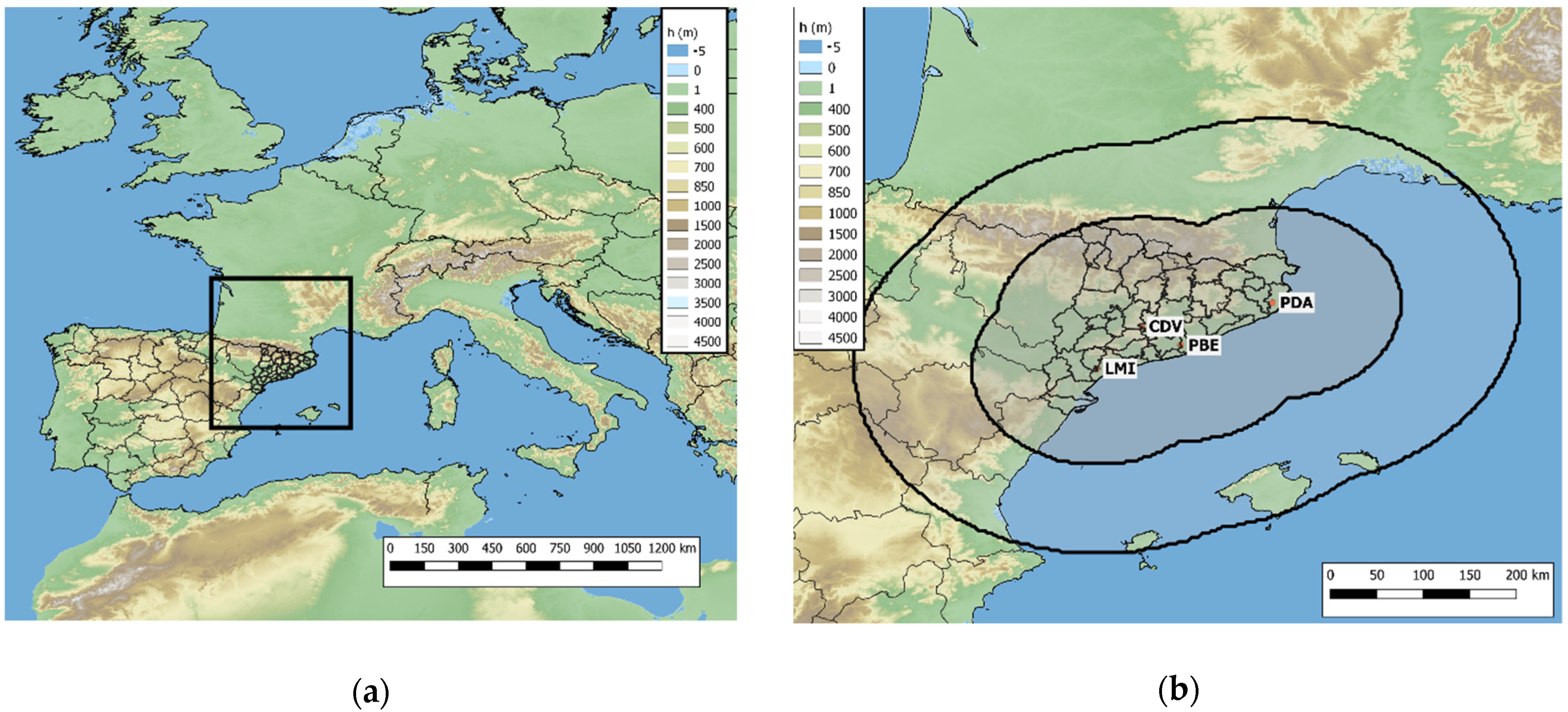
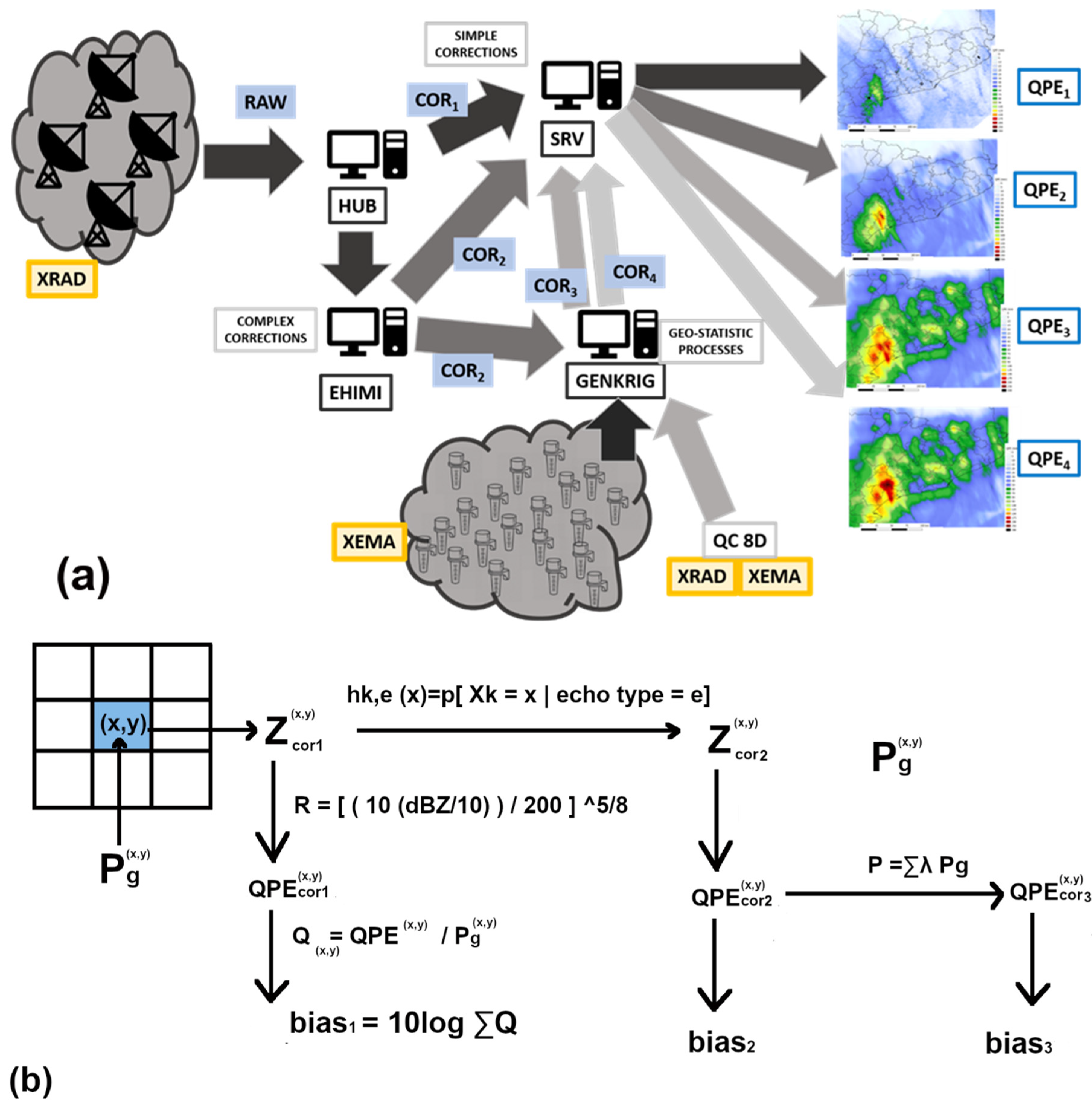
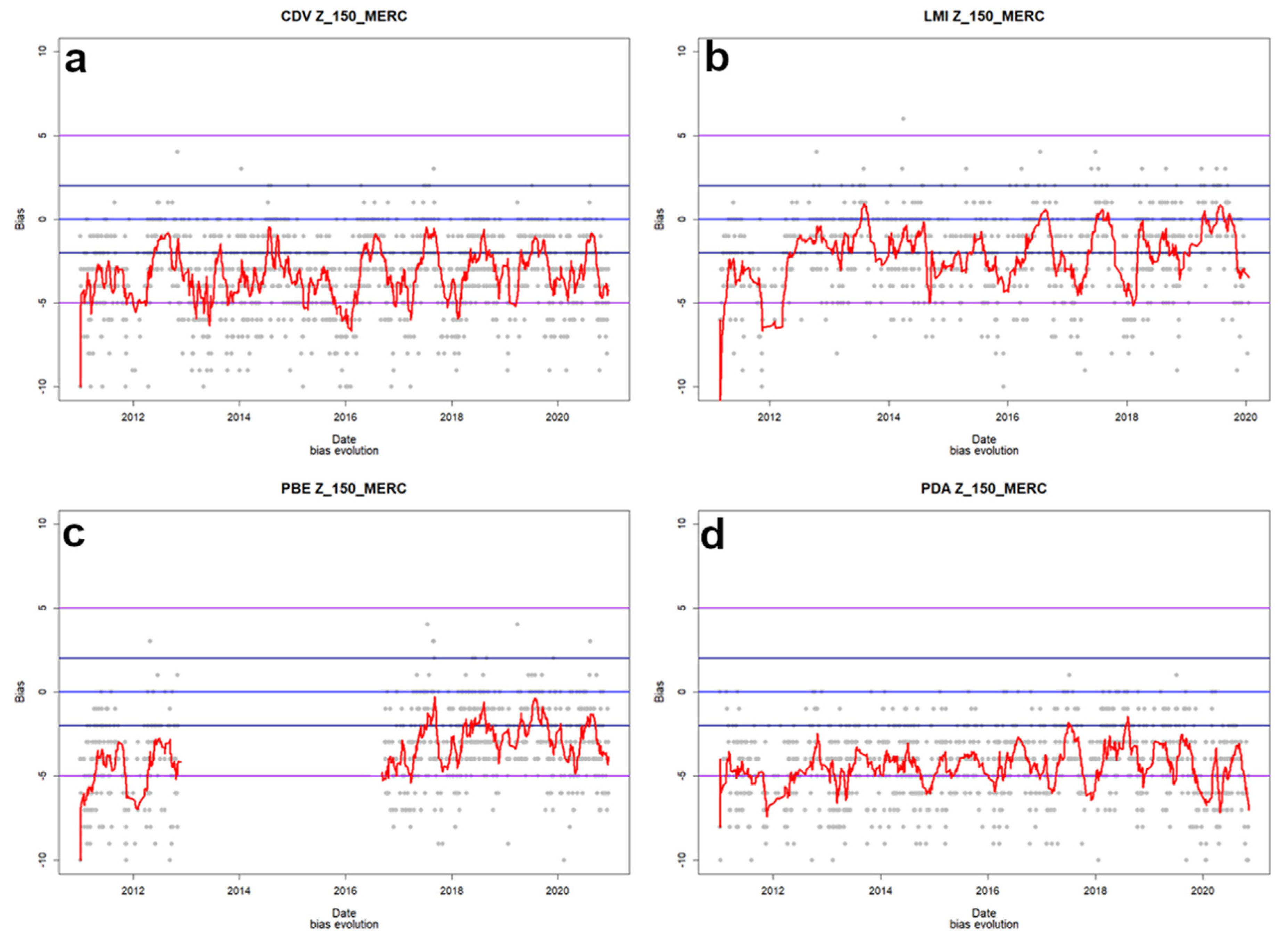
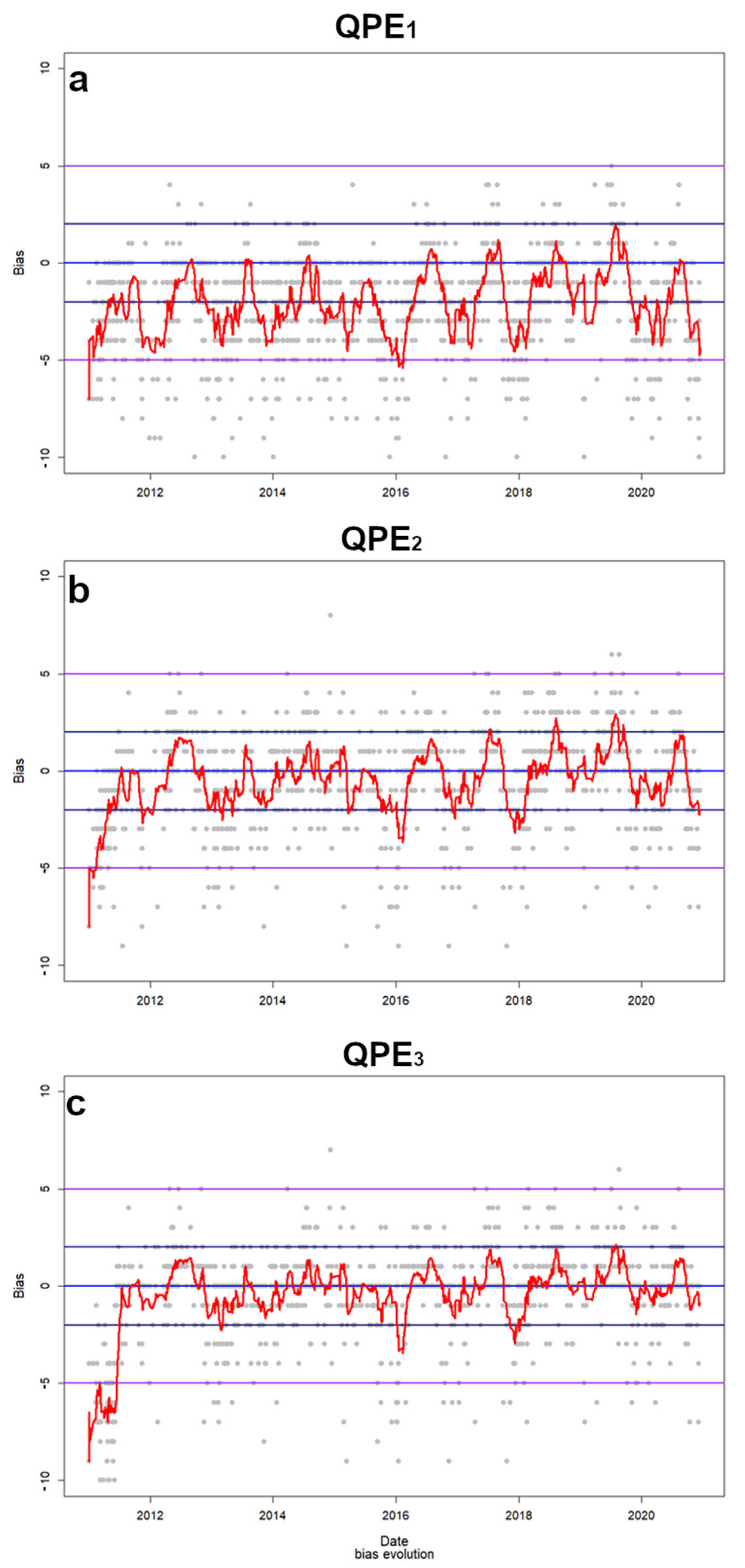
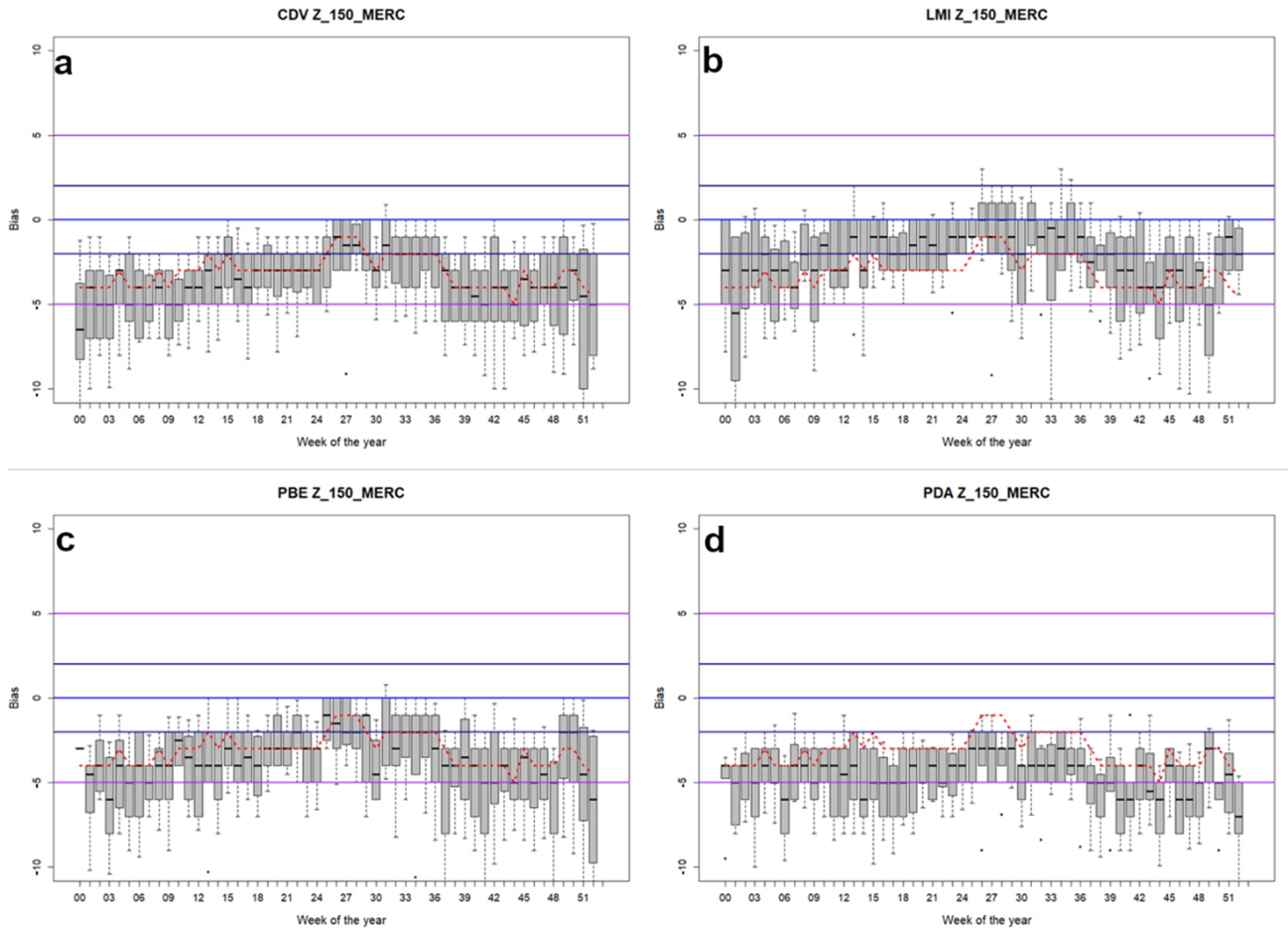
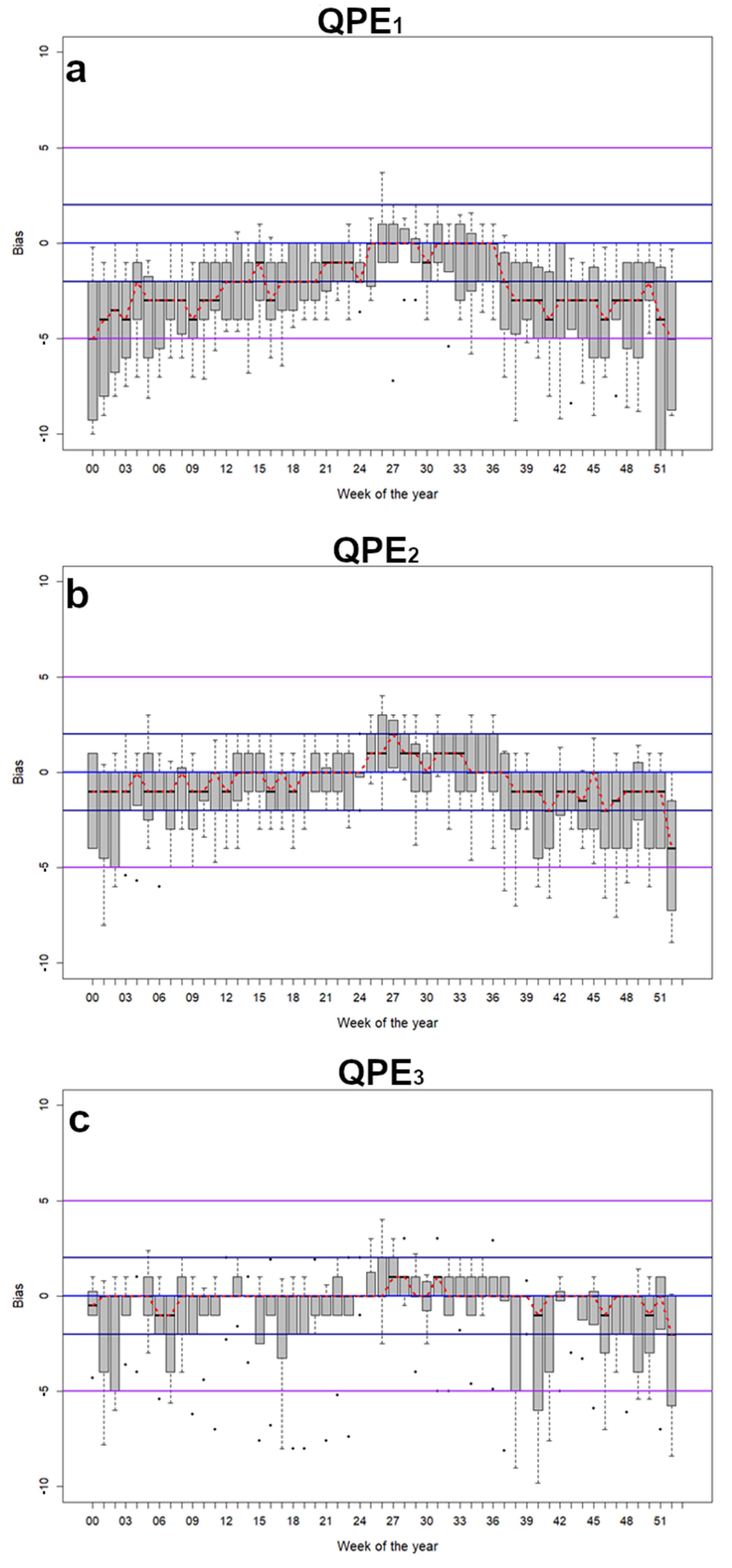

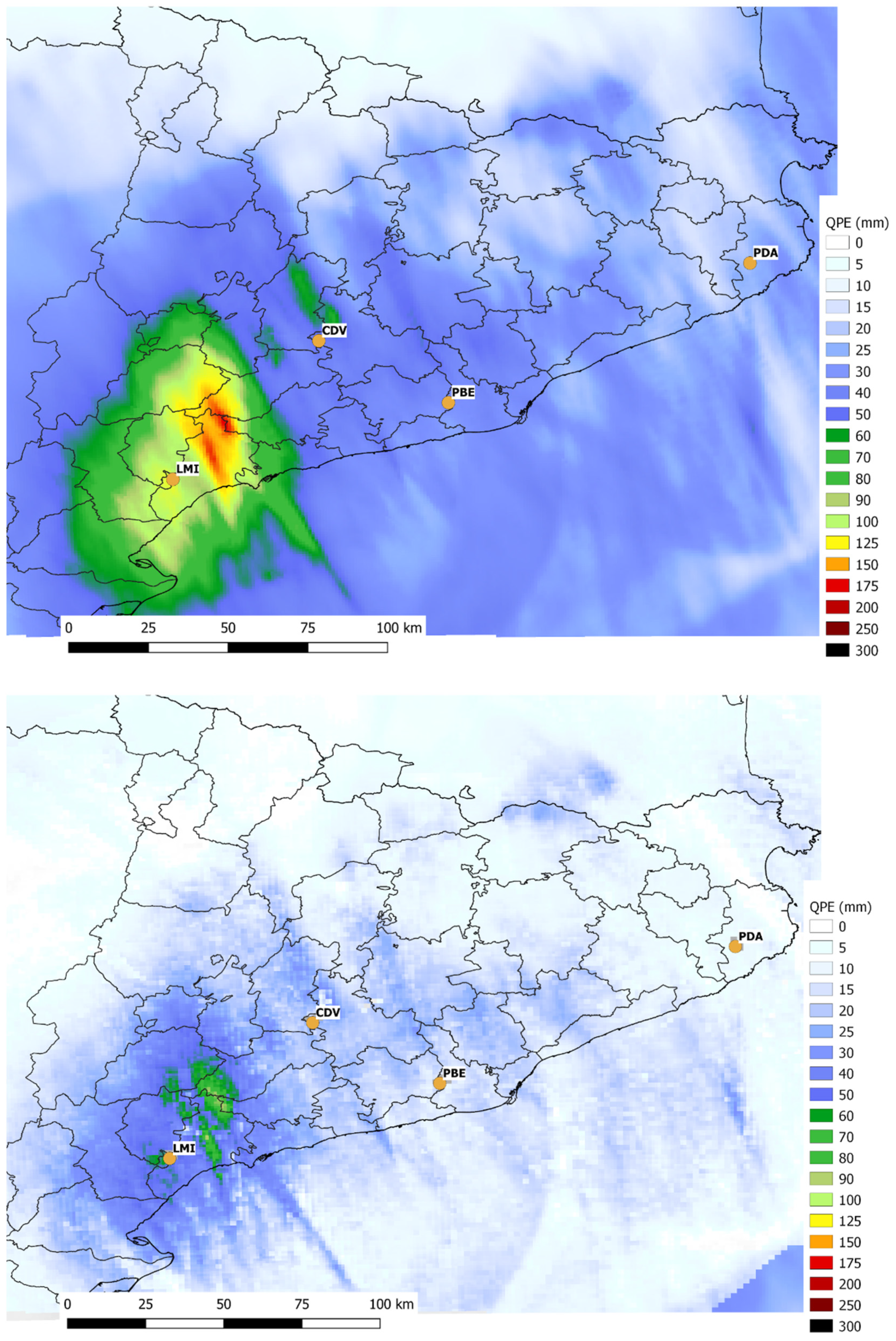
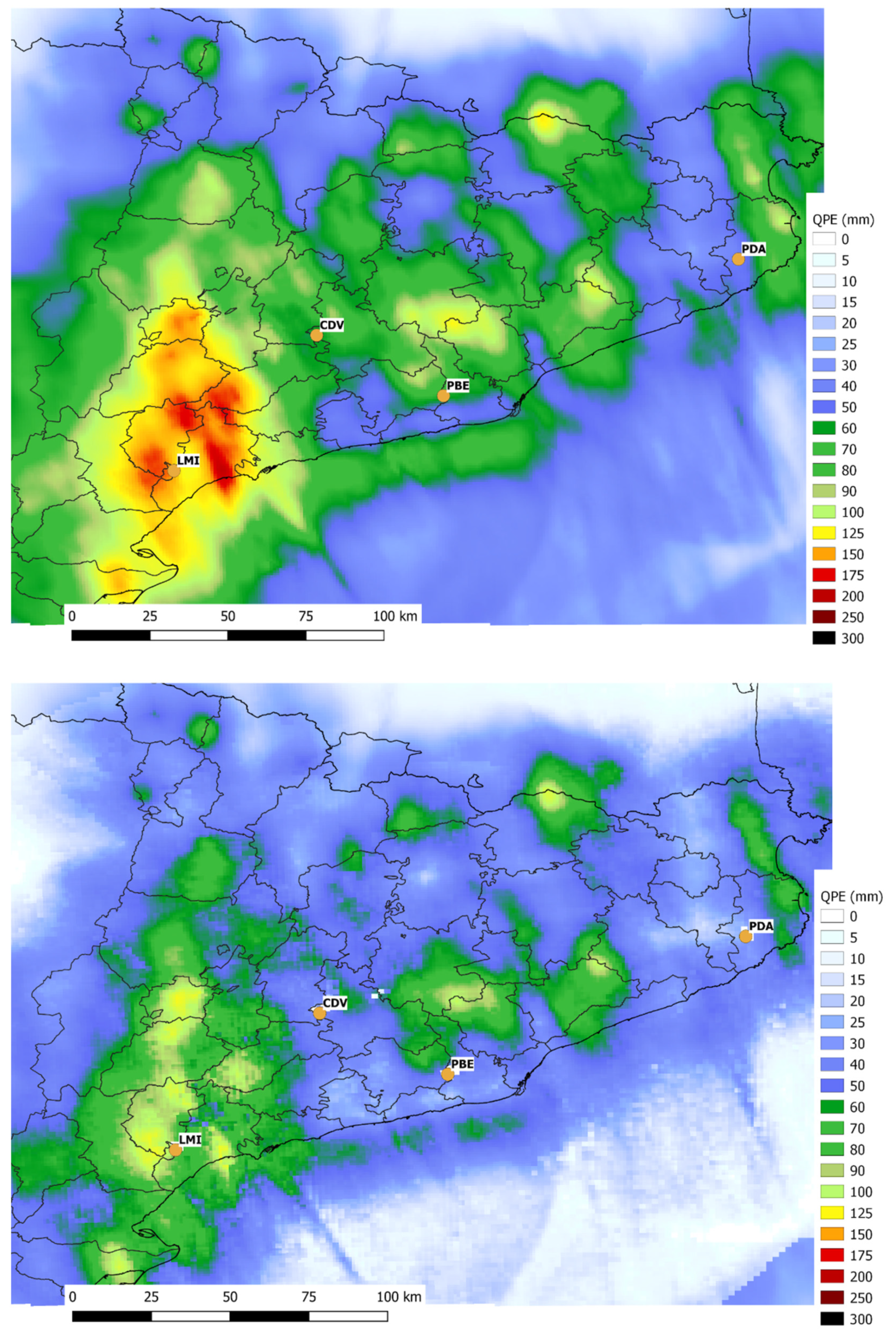
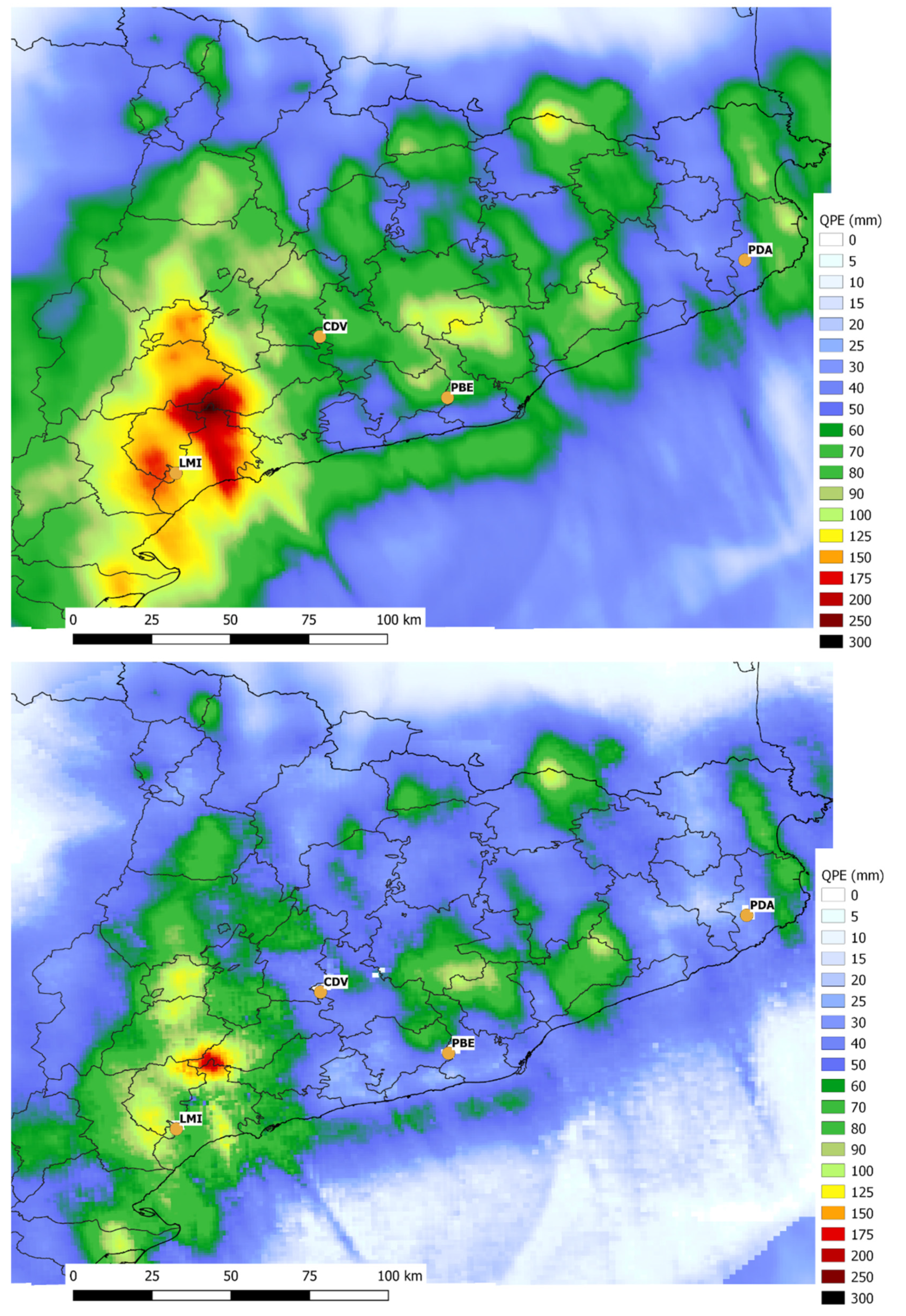
| Format Name | Description | Size (Kb) | Auxiliary Files |
|---|---|---|---|
| GeoTIFF | Georeferencing information to be embedded within a TIFF file | 131 | No |
| SAGA | System for Automated Geoscientific Analyses | 572 | 2 |
| ENVI | Format of ENVI software from ESRI | 286 | 2 |
| NetCDF | Network Common Data Format | 578 | No |
| IDRISI | Format of IDRISI software | 286 | No |
| ASCII | Format of ArcGis software (ESRI) | 548 | No |
| ERDAS | Erdas Imagine Image | 807 | No |
| Radar | Q0.0 | Q0.25 | Q0.5 | Q0.75 | Q1.0 |
|---|---|---|---|---|---|
| CDV | −6 | −5 | −3 | −2 | 0 |
| LMI | −5 | −3 | −2 | 0 | 1 |
| PBE | −6 | −5 | −3 | −2 | 0 |
| PDA | −7 | −6 | −4 | −3 | −2 |
| QPE1 | −5 | −3 | −2 | 0 | 0 |
| QPE2 | −3 | −2 | 0 | 1 | 2 |
| QPE3 | −3 | −2 | 0 | 1 | 2 |
| Field | SUM (mm) | MEAN (mm) | Q0.90 (mm) | N>100 | N>200 |
|---|---|---|---|---|---|
| QPE1 | 698,107 | 21.7 | 39.7 | 44 | 0 |
| QPE2 | 1,216,320 | 37.8 | 69.2 | 1222 | 0 |
| QPE3 | 2,356,831 | 73.3 | 116.1 | 4914 | 0 |
| QPE4 | 2,391,484 | 74.3 | 116.4 | 4969 | 189 |
Publisher’s Note: MDPI stays neutral with regard to jurisdictional claims in published maps and institutional affiliations. |
© 2021 by the authors. Licensee MDPI, Basel, Switzerland. This article is an open access article distributed under the terms and conditions of the Creative Commons Attribution (CC BY) license (https://creativecommons.org/licenses/by/4.0/).
Share and Cite
Rigo, T.; Llasat, M.C.; Esbrí, L. The Results of Applying Different Methodologies to 10 Years of Quantitative Precipitation Estimation in Catalonia Using Weather Radar. Geomatics 2021, 1, 347-368. https://doi.org/10.3390/geomatics1030020
Rigo T, Llasat MC, Esbrí L. The Results of Applying Different Methodologies to 10 Years of Quantitative Precipitation Estimation in Catalonia Using Weather Radar. Geomatics. 2021; 1(3):347-368. https://doi.org/10.3390/geomatics1030020
Chicago/Turabian StyleRigo, Tomeu, Maria Carmen Llasat, and Laura Esbrí. 2021. "The Results of Applying Different Methodologies to 10 Years of Quantitative Precipitation Estimation in Catalonia Using Weather Radar" Geomatics 1, no. 3: 347-368. https://doi.org/10.3390/geomatics1030020
APA StyleRigo, T., Llasat, M. C., & Esbrí, L. (2021). The Results of Applying Different Methodologies to 10 Years of Quantitative Precipitation Estimation in Catalonia Using Weather Radar. Geomatics, 1(3), 347-368. https://doi.org/10.3390/geomatics1030020








